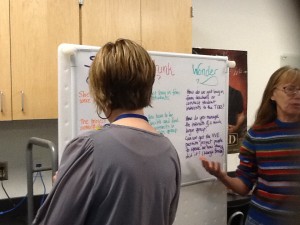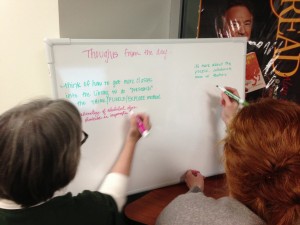How can we become students of one another’s learning? Engaging in our Professional Learning Networks(PLNs) through Twitter, Instagram, blogs, etc. provides us opportunities to become aware of best practices and gain a lot of breadth of experience. But even deeper power lies when we engage in a deeper way with those shared learnings.
Putting sharing in action
At our recent district librarian workshop, I decided to use other blog posts about best practices as our “texts” for further thought and reflection. Using the See, Think, Wonder strategy, we took three rich blog posts on research strategies for libraries and engaged with them. (The pieces were Shannon McClintock Miller’s Rainbow Loom blog posts, Buffy Hamilton’s Think, Puzzle and Explore post, and the third was Andy Plemmons’ Genius Con post.)

The librarians, in grade level teams, used our new Huddleboards to collaborate on their impressions of each reading, and then shared for conversation with the larger team. We were also fortunate that Buffy could also join us via audio for a 30 minute discussion of some of the “wonderings” from our encounter with her blog post.
The richness of this activity as a learning experience went beyond what I had anticipated. The reflections of bloggers in my PLN became a source of learning for our whole district. Reading about the experiences of other librarians, instead of hearing someone like me tell about them, and engaging their sense of discovery made for a powerful learning day. I loved the way the See, Think, Wonder and Think, Puzzle, Explore strategies helped engender this as well. But what was equally meaningful that my library colleagues had taken the time to write in detail about their own work with students and openly share what they were learning, how they retooled, and what was successful.
Why Sharing Matters
Santa Rosa Superintendent Jennie Oliver illuminated the power of learning from colleagues beautifully in her ASCD post, On the Moral Obligation of Sharing. Oliver quotes George Siemens:
“It’s not what it does for me, but rather what I am now able to do with and for others…What’s important with a PLN is not ‘what it does for me’ but rather how I can use it to change things in education, society, or the world.”
Oliver also references Dean Shareski’s K12 Online talk Sharing: The Moral Imperative: “Shareski argues that sharing our learning regularly with others is an ethical obligation, one rooted in our responsibility to educate all students, not just the ones within our schools and districts, but also those in the wider global community.”
She concludes with a realization that “It is not seeking knowledge for my own benefit, but creating and sharing with others to work toward a larger purpose that matters.”
Not only when we take time to share our practices in deep ways, but also when we take opportunities to reflect on the learning others have shared in a deeper way, the power of engaging with sharing is evident.
After a day of engaging with these texts and conversations, our librarians came away with more knowledge and more questions about inquiry circles, connected learning, Visible Thinking strategies, Stripling’s Wonder Inquiry model, write-arounds, the work of BIE, and the #GeniusCon concept, all thanks to the generosity of colleagues who shared their work so freely.
This circles around to my previous post on ways to improve professional development — by just thoughtfully curating materials for our librarians to engage with they were provided opportunities to have their own discussions, wonderings, and questions. The Visible Thinking models provided them opportunities to figure out what they want to know or need to know. When we are willing to let professional learning unfold naturally, powerful learning can happen.
Thanks for sharing
Thanks again to all my colleagues who share their work so generously, and as Jennie Oliver notes, “Siemens and Shareski both make the case that sharing is not just a ‘nice thing to do,’ but it is essential in building a sharing culture that is ultimately grounded in our moral purpose to educate children….to share and refine our learning along the way as a contribution to the greater good for students within our schools and beyond.”
Postscript:
Other blog posts/materials we used for exploration:
Musical peer review
Visible Thinking Routines
Introducing Friction (Debbie Abilock)
Stripling Inquiry Model
Power of reflection – Created with Haiku Deck, presentation software that inspires
